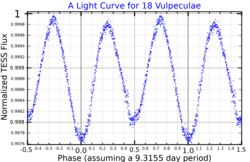18 Vulpeculae
| Observation data Epoch J2000.0 Equinox J2000.0 | |
|---|---|
| Constellation | Vulpecula |
| Right ascension | 20h 10m 33.53707s[2] |
| Declination | +26° 54′ 15.0033″[2] |
| Apparent magnitude (V) | 5.51[3] |
| Characteristics | |
| Spectral type | A3III or A3V[4] |
| B−V color index | 0.087±0.003[3] |
| Variable type | δ Sct,[5] EL[6] |
| Astrometry | |
| Radial velocity (Rv) | −11.70±0.11[4] km/s |
| Proper motion (μ) | RA: 18.785±0.164[2] mas/yr Dec.: 12.694±0.172[2] mas/yr |
| Parallax (π) | 6.6678 ± 0.1098 mas[2] |
| Distance | 489 ± 8 ly (150 ± 2 pc) |
| Absolute magnitude (MV) | −0.05[3] |
| Orbit[4] | |
| Period (P) | 9.314077±0.000039 d |
| Eccentricity (e) | 0.0116±0.0019 |
| Periastron epoch (T) | 2454875.09±0.25 HJD |
| Argument of periastron (ω) (secondary) | 319.4±0.97° |
| Semi-amplitude (K1) (primary) | 78.33±0.13 km/s |
| Semi-amplitude (K2) (secondary) | 82.80±0.29 km/s |
| Details[5] | |
| 18 Vul A | |
| Mass | 2.4 M☉ |
| Radius | 3.5±0.3 R☉ |
| Surface gravity (log g) | 3.73±0.07 cgs |
| Temperature | 8300±300 K |
| 18 Vul B | |
| Mass | 2.2 M☉ |
| Radius | 2.4±0.2 R☉ |
| Other designations | |
| Database references | |
| SIMBAD | data |
18 Vulpeculae is a binary star[5] system in the northern constellation of Vulpecula, located about 489 light years away from the Sun.[2] It is visible to the naked eye as a faint, white-hued star with a combined apparent visual magnitude of 5.51.[3] The system is moving closer to the Earth with a heliocentric radial velocity of −11.7 km/s.[4]
This is a double-lined spectroscopic binary system with an orbital period of 9.3 days and a small eccentricity of 0.0116.[4] It is a detached binary with a semimajor axis of 0.14742 ± 0.00047 AU. The system contains a Delta Scuti variable,[5] but the temperature places it to the blue (hotter) side of the δ Scuti instability strip. The AAVSO classifies it as a rotating ellipsoidal variable.[6] The combined stellar classification of this system remains unclear, with classes of A3 III, A1 IV, A3 V, and A2 IV being given. The ultraviolet spectrum matches an A3 dwarf star. It shows no spectral peculiarities.[4]
References
[edit]- ^ "MAST: Barbara A. Mikulski Archive for Space Telescopes". Space Telescope Science Institute. Retrieved 27 August 2024.
- ^ a b c d e f Brown, A. G. A.; et al. (Gaia collaboration) (August 2018). "Gaia Data Release 2: Summary of the contents and survey properties". Astronomy & Astrophysics. 616. A1. arXiv:1804.09365. Bibcode:2018A&A...616A...1G. doi:10.1051/0004-6361/201833051. Gaia DR2 record for this source at VizieR.
- ^ a b c d Anderson, E.; Francis, Ch. (2012). "XHIP: An extended hipparcos compilation". Astronomy Letters. 38 (5): 331. arXiv:1108.4971. Bibcode:2012AstL...38..331A. doi:10.1134/S1063773712050015. S2CID 119257644.
- ^ a b c d e f Fekel, Francis C.; et al. (2013). "New Precision Orbits of Bright Double-lined Spectroscopic Binaries. VIII. HR 1528, HR 6993, 2 Sagittae, and 18 Vulpeculae". The Astronomical Journal. 146 (5). 129. Bibcode:2013AJ....146..129F. doi:10.1088/0004-6256/146/5/129. hdl:2152/34407. S2CID 121155872.
- ^ a b c d Liakos, Alexios; Niarchos, Panagiotis (2017). "Catalogue and properties of δ Scuti stars in binaries". Monthly Notices of the Royal Astronomical Society. 465 (1): 1181. arXiv:1611.00200. Bibcode:2017MNRAS.465.1181L. doi:10.1093/mnras/stw2756. S2CID 119284575.
- ^ a b "18 Vul". The International Variable Star Index. AAVSO. Retrieved 17 September 2024.
- ^ "18 Vulpeculae". SIMBAD. Centre de données astronomiques de Strasbourg. Retrieved 2018-11-18.
External links
[edit]- 18 Vulpeculae on WikiSky: DSS2, SDSS, GALEX, IRAS, Hydrogen α, X-Ray, Astrophoto, Sky Map, Articles and images

